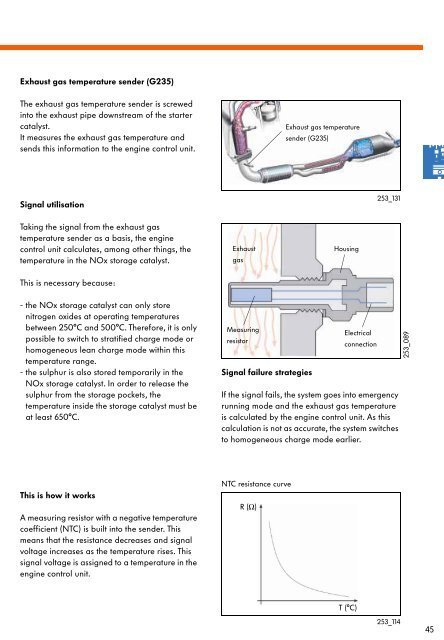Direct Petrol Injection System with Bosch Motronic MED 7 - Volkspage
Direct Petrol Injection System with Bosch Motronic MED 7 - Volkspage
Direct Petrol Injection System with Bosch Motronic MED 7 - Volkspage
Create successful ePaper yourself
Turn your PDF publications into a flip-book with our unique Google optimized e-Paper software.
Exhaust gas temperature sender (G235)<br />
The exhaust gas temperature sender is screwed<br />
into the exhaust pipe downstream of the starter<br />
catalyst.<br />
It measures the exhaust gas temperature and<br />
sends this information to the engine control unit.<br />
Exhaust gas temperature<br />
sender (G235)<br />
Signal utilisation<br />
253_131<br />
Taking the signal from the exhaust gas<br />
temperature sender as a basis, the engine<br />
control unit calculates, among other things, the<br />
temperature in the NOx storage catalyst.<br />
Exhaust<br />
gas<br />
Housing<br />
This is necessary because:<br />
- the NOx storage catalyst can only store<br />
nitrogen oxides at operating temperatures<br />
between 250°C and 500°C. Therefore, it is only<br />
possible to switch to stratified charge mode or<br />
homogeneous lean charge mode <strong>with</strong>in this<br />
temperature range.<br />
- the sulphur is also stored temporarily in the<br />
NOx storage catalyst. In order to release the<br />
sulphur from the storage pockets, the<br />
temperature inside the storage catalyst must be<br />
at least 650°C.<br />
Measuring<br />
resistor<br />
Signal failure strategies<br />
Electrical<br />
connection<br />
If the signal fails, the system goes into emergency<br />
running mode and the exhaust gas temperature<br />
is calculated by the engine control unit. As this<br />
calculation is not as accurate, the system switches<br />
to homogeneous charge mode earlier.<br />
253_089<br />
This is how it works<br />
A measuring resistor <strong>with</strong> a negative temperature<br />
coefficient (NTC) is built into the sender. This<br />
means that the resistance decreases and signal<br />
voltage increases as the temperature rises. This<br />
signal voltage is assigned to a temperature in the<br />
engine control unit.<br />
NTC resistance curve<br />
R (Ω)<br />
T (°C)<br />
253_114<br />
45

















